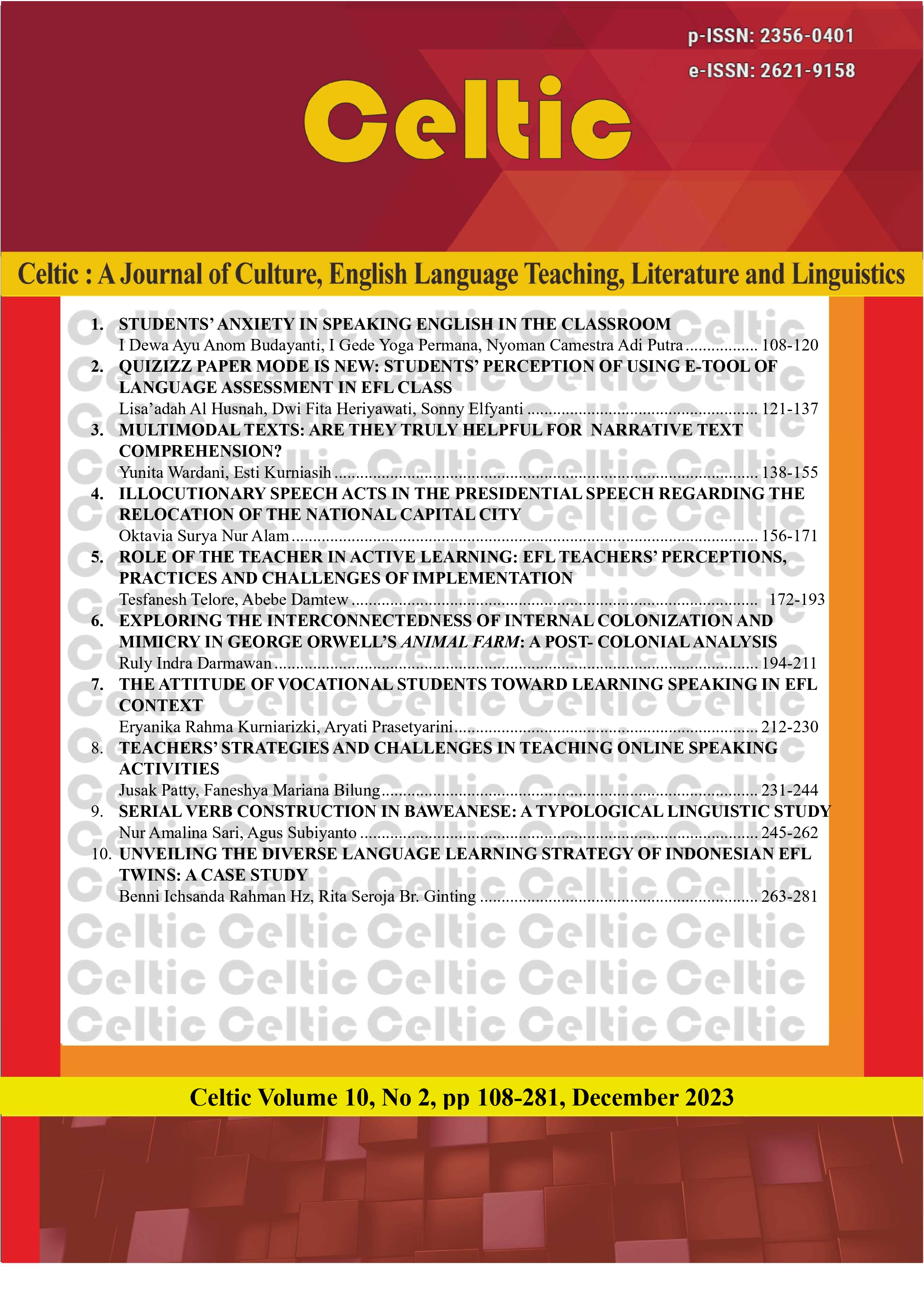ROLE OF THE TEACHER IN ACTIVE LEARNING: EFL TEACHERS’ PERCEPTIONS, PRACTICES AND CHALLENGES OF IMPLEMENTATION
DOI:
https://doi.org/10.22219/celtic.v10i2.28096Abstract
The current study was mainly aimed at exploring teachers’ perceptions, practices, and challenges of implementing their role in active learning. The total population of the study were 37 English language teachers in Kambata Tembaro Zone, Ethiopia. Data for the study were collected via a questionnaire and focus group discussion. The data collected via a questionnaire were analyzed quantitatively by using statistical package for social science and qualitative method of analysis was applied for the data gathered via focus group discussion. The findings of the study revealed that teachers lack clear understanding of their role in active learning and they were not properly accomplishing it in teaching the English language. Knowledge, skill, and aptitude gaps among teachers and students and unsuitable school environments were reported as major challenges affecting the implementation of active learning. Awareness creation and capacity-building workshops were recommended for the teacher and students to improve the implementation of active learning in secondary schools in Ethiopia.
Downloads
References
Arruda, H.; Silva, É.R. (2021). Assessment and Evaluation in Active Learning
Implementations: Introducing the Engineering Education Active Learning Maturity Model. Educ. Sci. 11, 690. https://doi.org/10.3390/ educsci11110690
Arbona (2016). The Role of the Teacher in Interactive Teaching. Cyril and Methodius University, Skopje, Macedonia. DOI: 10.5937/IJCRSEE1601031X
Ayele, E. (2017). An Exploration of Teachers' Challenges and Practices in
Implementing Active Learning Strategies, American Journal of Art and Design. Volume 2, Issue 2, pp. 42-51. doi:10.11648/j.ajad.20170202.12
Ayele, D. (2014). Teachers' job satisfaction and commitment in general secondary schools of Hadiya zone in southern nation nationality and people of the regional state: Jimma University, Jimma.
Baru Aboma Totoba (2021). Factors Affecting the Implementation of Active
Learning Methods in Bale Zone Secondary Schools. Research on Humanities and Social Sciences www.iiste.org ISSN 2224-5766 (Paper) ISSN 2225-0484 (Online) Vol.11, No.1
Birhanu, M.A. (2013). Active learning approaches in mathematics education at
Universities in Oromia, Ethiopia. Unpublished PhD Dissertation. University of South Africa. http://uir.unisa.ac.za/bitstream/handle/10500/4133/thesis_alemu_b.pdf
Brad, Hayes (2000) Teacher-Centered Instruction Vs Student-Centered
Instruction: Armuche High School. American Government Schools (http://www.Secondaryschools.com/approach.html
Bucharest (2010). Student-centered learning insight in Theory and Practice European
students' union.
Carr, R., Palmer, S., & Hagel, P. (2015). Active learning: the importance of developing a comprehensive measure. Active Learning in Higher Education 16, 173-186.
Chemir, S & Kitila, T. (2022). English for academic purposes learners' needs
analysis: Language difficulties encountered by university students in Ethiopia. Celtic: A Journal of Culture, English Language Teaching, Literature and Linguistics, 9(1), 97-119.Doi: 10.22219/celtic.v9i1.20646
Dereje Asfaw Bulbula, Damtew Bulbula, Fedila Abazinab Abajobir and Tesfa Alemu Bulti (2022). The Practices and Challenges in the Implementation of Participatory Teaching Strategies in English as a Foreign Language Large Classes in Ethiopia. DOI: https://doi.org/10.21203/rs.3.rs-1400991/v2
Devira, M. (2020). Revisiting the implementation of Active Learning Pedagogy in
EFL classrooms. Studies in English Language and Education, 7(1), 223-236
Eba, M. (2013). The Need for Professional Growth of ELT Teachers in Ethiopia. Star journal. ISSN: 2226-7522(Print) and 2305-3327 (Online).
Eba, M. (2014). Practices and Impeding Factors in the Teaching of English to Young
Learners Sci. Technol. Arts 3(2): 201-212.http://www.starjournal.org/
Fredson S. (2015).The relationship between teachers and students in the classroom: Communicative Language Teaching Approach and Cooperative Learning Strategy to Improve Learning. Item 22. Available at http://vc.bridgew.edu/theses/22
Firew, M. (2008). A Study of High School Students' English Learning Anxiety and
English Achievement: Addis Ababa University, Retrieved from http://etd.aau.edu.et/handle/123456789/8226?show=full
Gerencheal, B. (2016). Gender Differences in Foreign Language Anxiety at an
Ethiopian University: MizanTepi University Third Year English Major Students in Focus, 1(1), 1–16
Gómez-Puig, M., & Stoyanova, A. (2022). Learning by engaging: Using active
learning strategies in higher education. REIRE Revistad'Innovació i Recerca en Educació, 15(2), 1–4. https://doi.org/10.1344/reire.39770
Gillies, R. M. Ashman A. F. and Terwel J. (2008). The Teacher's Role in
Implementing Cooperative Learning in the Classroom Pierre. Dillenbourg Swiss Federal Institute of Technology Bingley, UK: Emerald Group Publishing.
Tudor I. (2016). The learner-centered classroom. Penn State University (Paterno
Lib) Downloaded from http://eltj.oxfordjournals.org/.
Jeremy E. Sawyer, Rita Obeid, Dennis Bublitz, Anna M. Schwartz, and Patricia J.
Brooks (2017). Which Forms of Active Learning are Most Effective: Scholarship of Teaching and Learning in Psychology, Vol. 3, No. 4, 257–271 2332-2101/17/ http://dx.doi.org
Kefialew Yenyet (2021). Challenges to Implementing Active Learning in Amhara
Region Police College, Amhara Region, Ethiopia. Journal of Education and Practice www.iiste.or ISSN 2222-1735 (Paper) ISSN 2222-288X (Online) Vol.12, No.1
Kovács, G. (2018). "Culture in Language Teaching". Acta Universitatis Sapientiae,
Philologica, 9(3) 73-86. https://doi.org/10.1515/ausp-2017-0030.
Mello, David, Less., & Colleen A. (2013). Effectiveness of active learning in the arts and Sciences: Humanities Department Faculty Publications & Research. Paper 45. http://scholarsarchive.jwu.edu/humanities_fac/45
Michael K, Alemu M, Desie Y, Atnafu M, Assefa S, Regassa C, Wodaj H, Abate A. (2023). Understanding and practice of active learning among upper primary school science and mathematics teachers. Heliyon. 9(6):e16854. doi: 10.1016/j.heliyon.2023.e16854.
MOE. (2003). TESO Pre-Service Committee a Notional Curriculum Guideline for Pre-Service Teacher Education Programs. Addis Ababa (unpublished)
Mulatu, M., & Bezabih, W. (2018). Perceptions and practices of EFL teachers in implementing active learning in English classes: International Journal of Education, 10(2), 88-94. doi http://dx.doi.org.
Mulugeta, A., Mebit, B., & Endeshaw, A. (2021). Assessing the Students and EFL
Teachers' Perception and Practice of Active Learning: International Journal of Education, Culture, and Society.Vol.6, No.4, pp. 92-98. doi 10.11648/j.ijecs.20210604.11
Olusegun, S. and Bada d., (2015). Constructivism Learning Theory: A Paradigm for
Teaching and Learning Department of Psychology Federal University of Education, Kano IOSR Journal of Research & Method in Education (IOSR-JRME) e-ISSN: 2320–7388, www.iosrjournals.org
Paragae, I, G, A, P, N, S. (2023). Innovative Teaching Strategies in Teaching English as a Foreign Language. English Teaching and Linguistics Journal, 4(1), 1-9.
Richards, J. C., & Rodgers, T. E. (2011). Approaches and Methods in Language
Teaching (Cambridge Language Teaching Library). 2nd ed. Cambridge: Cambridge University Press
Vighnarajah, Wong Su Luan and Kamariah Abu Bakar (2008). The Shift in the Role of Teachers in the Learning Process European Journal of Social Sciences – Volume 7, Number 2 33.
Slavin, R. (2014). Cooperative Learning and Academic Achievement: Why Does Group work Work? Anales de psicología, 30(3), 785-791. doi.org/10.6018/analesps.30.3.201201
Surachai, Y., (2020). Perceptions and practices of EFL school teachers on implementing active learning in Thai English language classrooms. Thai Tesol Journal 33(1)
Tadesse, A., & Daniel, T. (2016) Assessment of the practice and its determinant factors of active learning methodologies by teachers of Teacher Education Colleges Begemidir and Gondar. British Journal of Education 4(1):32-50. Retrieved October 12, 2018, from (www.eajournals.org)
Teshome Nekatibeb Begna (2017) Classroom Participation and Development of
Student Attitudes: A Study of Active Learning Practices in Ethiopia. Volume 4, Issue 3, PP 67-85 ISSN 2349-0373 (Print) http://dx.doi.org/10.20431/2349-0381.0403008 www.arcjournals.org
Utami, L. P., & Sulistyaningrum, S. D. (2022). The Incorporation of Communication Skills in Public Speaking Course Syllabus at English Language Education Study Program. Celtic: A Journal of Culture, English Language Teaching, Literature and Linguistics, 9(1)1-20. Doi: 10.22219/celtic.v9i1.18281.
Wahyuningtyas, D. ,&Savitri, A.(2022). The Use of Drama Wayang in ESP Speaking Class Final Assignment. Celtic: A Journal of Culture, English Language Teaching, LiteratureandLinguistics, 9(1), 21-38.Doi: 10.22219/celtic.v9i1.17767
Downloads
Published
How to Cite
Issue
Section
License
Copyright (c) 2023 Tesfanesh Telore, Abebe Damtew

This work is licensed under a Creative Commons Attribution-ShareAlike 4.0 International License.
- Authors retain copyright to publish without restrictions and grant the journal right of first publication with the work simultaneously licensed under a Creative Commons Attribution License that allows others to share the work with an acknowledgement of the work's authorship and initial publication in this journal.
- Authors are able to enter into separate, additional contractual arrangements for the non-exclusive distribution of the journal's published version of the work (e.g., post it to an institutional repository or publish it in a book), with an acknowledgement of its initial publication in this journal.
- Authors are permitted and encouraged to post their work online (e.g., in institutional repositories or on their website) prior to and during the submission process, as it can lead to productive exchanges, as well as earlier and greater citation of published work.














